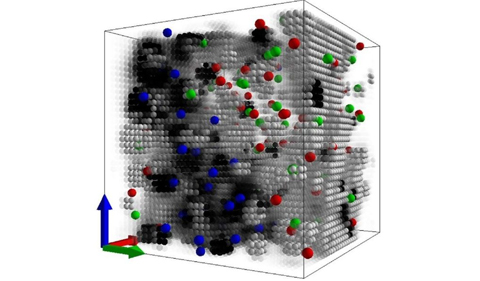
The authors modeled space-projected conductivity of several CBRAM materials. In this figure, oxygen atoms are shown in red, copper atoms in blue, and aluminium atoms in green.
By Amanda Biederman
NQPI editorial intern
In a paper published in Rapid Research Letters this week, a team of current and former Ohio University researchers reported a new theoretical method to determine the electrical conductive properties of a type of material that is important for the development of new computer memory devices.
The paper, titled “Spatial Projection of Electronic Conductivity: The Example of Conducting Bridge Memory Materials,” was authored by recent alum Dr. Kiran Prasai (Ph.D., 2017); current graduate students Kashi Subedi and Kaelyn Ferris; former postdoctoral researcher Parthapratim Biswas; and Dr. David Drabold, Distinguished Professor of Physics & Astronomy. Drabold and Dr. Gang Chen, Associate Professor of Physics & Astronomy, are currently funded by the National Science Foundation to research these materials.
Conducting bridge random access memory (CBRAM) materials are likely to be key in the development of next-generation computer memory systems. CBRAM is non-volatile, meaning that it can retrieve stored data without requiring a continuous power source.
“The utility of the materials is well established, but the understanding of atomistic processes that enable memory operation is highly incomplete,” Drabold said.
The team modeled two different CBRAM materials, one involving an oxide (alumina) matrix and the other a chalcogenide matrix. They found that in the oxide, the copper ions clustered together. This behavior was not observed in the chalcogenide. This revealed a fundamental difference in how practical CBRAM devices function, depending upon their chemical composition.
To determine the electronic consequences of these discoveries, the team estimated a space-projected conductivity using a standard result known as the Kubo-Greenwood formula. From these calculations, they were able to determine which parts of a network are capable of conducting an electric current.
“In its usual form the Kubo formula just estimates the conductivity, but does not indicate conduction-active parts of the material,” Drabold said.
The team wrote that their analyses have provided novel insights the atomic structure of CBRAM devices. Additionally, they have shown how to use the Kubo formula to gain detailed insight into electronic conduction in this and many other advanced materials.
Abstract: Conducting bridge random access memory materials have special promise for FLASH memory, other applications beside, and also special potential for continued miniaturization. They are electronic materials of unique flexibility. Here, we offer new models of Cu‐doped alumina, and reveal qualitative differences in the behavior of transition metal ions in chalcogenide and oxide hosts, showing that Cu clusters in an amorphous alumina host, in contrast with chalcogenides in which the metal atoms do not cluster. We further elucidate the processes of electron transport. To determine these, the Kubo–Greenwood formula is cast in a form to enable the estimate of a space‐projected conductivity. The method reveals those parts of the networks that may conduct a current (or absorb radiation at frequency ω).



















Comments